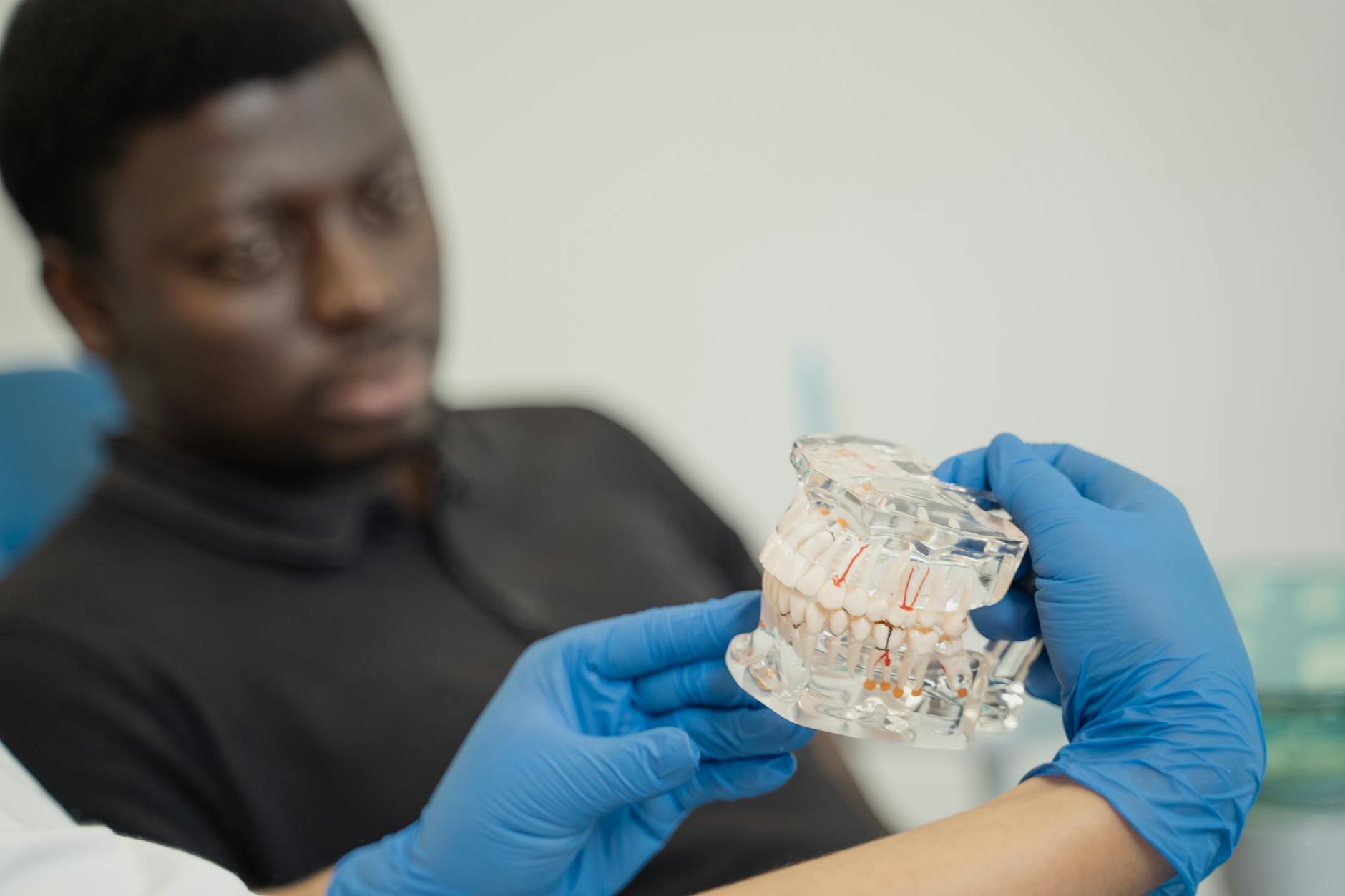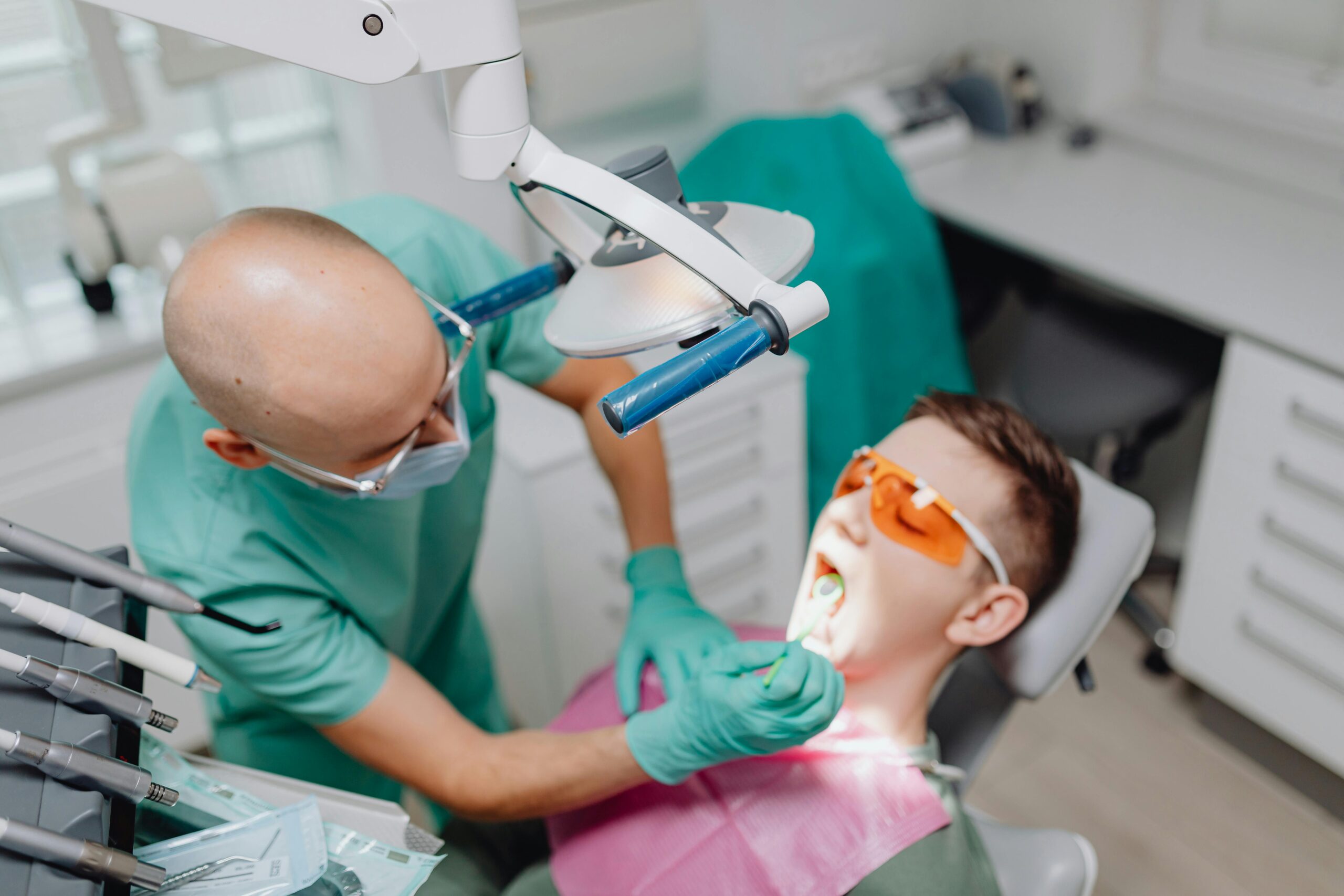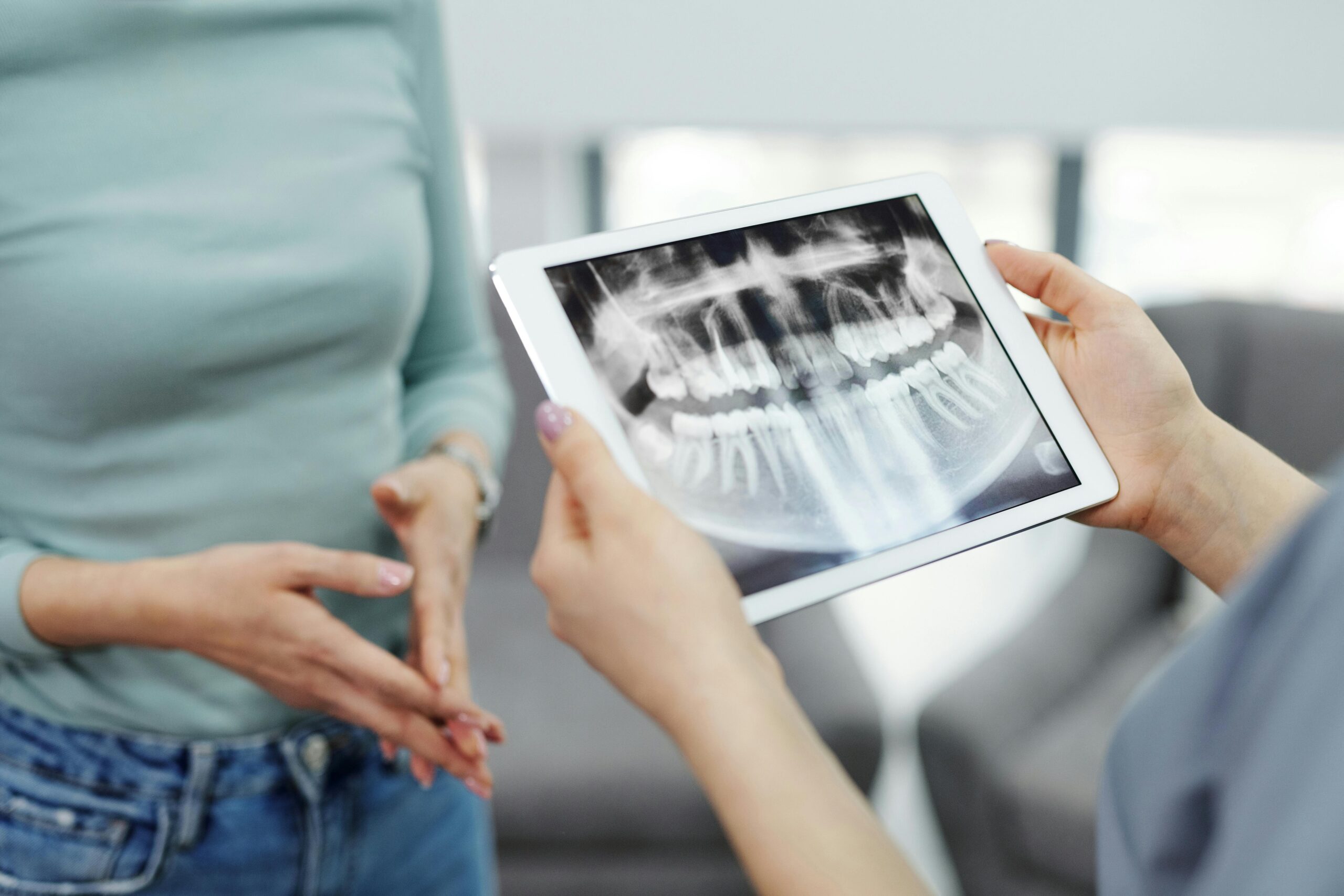Case Overview
A middle-aged patient came in with sharp pain on biting a lower molar, especially with seeds and cold water. Clinical testing suggested a crack confined to the crown beneath a large, aging filling; the pulp response to cold was normal and radiographs showed no root involvement. We stabilized the tooth and restored it with a bonded ceramic onlay to splint the weakened cusps. This cracked molar onlay case report highlights a conservative path when the crack has not progressed into the nerve.
On exam, a bite test localized pain to the distolingual cusp, and transillumination traced a fine line from the distal marginal ridge. Probing depths were normal, cold testing was reversible, and the radiograph showed intact bone, supporting a crack limited to enamel and dentin. We removed the old filling, inspected the crack under magnification, and prepared a conservative onlay that unified the compromised cusps. A provisional protected the tooth until the final ceramic was bonded. After delivery, chewing was comfortable, and vitality remained normal at follow-ups.
- Avoid chewing hard foods on the sore side; choose softer textures.
- Keep the area clean with gentle brushing and flossing; avoid extremes of temperature.
- Over-the-counter pain relief may help if used as directed on the label.
- Contact a dentist promptly during business hours; seek urgent care sooner if swelling, fever, or severe pain appears.
Initial Presentation
In this cracked molar onlay case report, a healthy 46‑year‑old presented with sharp, intermittent pain on biting on the lower left first molar one week after chewing a hard seed, with a history of clenching and a small existing occlusal filling. Symptoms were worst on release and with cold; there was no swelling, fever, or spontaneous night pain. Exam reproduced pain on a selective bite test over the mesiobuccal cusp; probing and percussion were normal, mobility was within physiologic limits, the cold response was brisk and non‑lingering, and transillumination traced a crown‑confined mesiodistal crack; periapical radiographs were clear. Prompt in‑person evaluation during business hours is important; while waiting for your appointment, these simple steps may help.
- Chew on the opposite side and avoid hard, crunchy, or sticky foods that could propagate the crack.
- Choose room‑temperature foods and drinks; avoid very hot or ice‑cold items that can trigger sensitivity.
- If appropriate for you, consider over‑the‑counter pain relievers as directed on the label; never place aspirin on the tooth.
- Keep the area clean with gentle brushing and flossing; a brief lukewarm saltwater rinse can soothe the gum tissues.
- Avoid repeatedly “testing” the tooth by biting hard items; giving it rest reduces the risk of the crack propagating.
Diagnostic Workup
In this cracked molar onlay case report, the diagnostic workup focused on pinpointing the source of bite pain and confirming that the fracture was limited to the tooth’s crown. We combined patient history, chairside tests, and imaging to assess nerve health, evaluate the surrounding bone and gums, and decide whether the tooth could be predictably restored. The findings supported conservative cuspal coverage with an onlay rather than more extensive treatment.
- History: sharp pain on biting or release and brief cold sensitivity; no lingering ache or swelling.
- Visual inspection with magnification and transillumination to trace the crack’s path on the enamel.
- Selective bite testing on individual cusps to reproduce the symptom and localize the compromised cusp.
- Pulp vitality testing (cold/electric) indicating a healthy, promptly responsive nerve.
- Bitewing and periapical radiographs to assess existing restorations, decay, and bone; cracks rarely show directly on X-rays.
- Occlusal analysis to identify heavy contacts or grinding that may have contributed to the crack.
If you suspect a cracked tooth before you can be seen, avoid chewing on that side and very hard or sticky foods, steer clear of extreme temperatures, and consider over-the-counter pain relievers as directed. A warm saltwater rinse can soothe the area. Please arrange an in-person evaluation promptly during business hours—timely diagnosis helps keep treatment conservative and comfortable.
Treatment Plan
Our plan focused on conserving healthy tooth structure, relieving bite pain, and protecting the fractured cusp with a bonded onlay. After confirming the crack did not extend below the gumline or show signs of a vertical root fracture, we recommended an indirect onlay to cover the vulnerable cusps and distribute forces more evenly. We reviewed that, if symptoms persisted or deepened, the tooth might still require endodontic care, and we scheduled close follow-up to monitor the response.
- Diagnostic phase: history, focused exam, percussion and bite tests, cold testing, transillumination, and radiographs to map crack extent.
- Stabilization: smooth sharp edges and place a protective provisional if needed to splint cusps and reduce biting discomfort.
- Preparation: remove defective filling and decay, assess the crack under magnification, place a bonded foundation, and prepare an onlay with functional cusp coverage.
- Impressions/scans taken and a custom onlay fabricated; a well-sealed temporary maintained comfort and tooth position.
- Delivery: try-in for fit and contacts, bond the onlay, then refine the bite and polish. Post-op checks scheduled to track symptoms.
- At home, until the final restoration is placed and settled: chew on the opposite side, avoid very hard or sticky foods, and use over-the-counter pain relievers as directed on the label if needed. Call the office during business hours if pain worsens, sensitivity lingers, or a temporary loosens.
In this cracked molar onlay case report, the plan prioritized structural reinforcement and symptom relief while keeping options open should the nerve later show signs of irritation.
Procedure Highlights
In this cracked molar onlay case report, the aim was to stabilize a symptomatic posterior tooth and restore strength without resorting to a full crown. We began with a focused exam and imaging to verify that the crack involved enamel and dentin but spared the root; that allowed us to design a conservative onlay that splints the weakened cusps. Adhesive dentistry lets us remove only compromised tooth structure and bond a custom onlay that restores proper bite and helps prevent the crack from propagating. If you’re having similar symptoms, avoid chewing on that side, keep the area clean with gentle brushing and rinsing, and use over‑the‑counter pain relief as labeled—then contact our office during business hours so we can examine the tooth promptly.
- Assessment: symptom history, cold and bite tests, transillumination, photographs, and digital radiographs to map the crack.
- Isolation and anesthesia: protect the airway, control moisture, and ensure comfort.
- Conservative preparation: remove unsupported enamel, round internal angles, and cover at‑risk cusps while preserving sound tooth.
- Records and provisional: scan or impression for the lab and place a smooth temporary to shield the tooth between visits.
- Bonded delivery: try‑in, clean and prime tooth and onlay, adhesive cementation, excess cleanup, occlusal adjustment, and polish.
- Follow‑up: recheck comfort and bite, and discuss preventive habits to reduce future crack risk.
Materials Used in Onlay
For this case, we used a custom, tooth-colored ceramic onlay bonded with adhesive resin cement to stabilize the cracked cusps while preserving as much healthy tooth as possible. Isolation with a rubber dam kept the field clean and dry during bonding, which is essential for a lasting seal. A comfortable local anesthetic and a well-fitted provisional protected the tooth until final placement.
- High-strength, tooth-colored ceramic onlay (lab-fabricated or milled)
- Adhesive system: enamel/dentin etchant or self-etch primer, silane for ceramic, and dual-cure resin cement
- Isolation: rubber dam (or equivalent moisture control)
- Provisional (temporary) material to protect the tooth between visits
- Finishing and polishing instruments with occlusal marking paper
- Desensitizing agents as needed for comfort
Ceramic was chosen for strength, longevity, and enamel-like wear; when properly prepared (etched and silanated) and bonded, it helps distribute biting forces away from the crack. In this cracked molar onlay case report, material choices were guided by durability, seal, and conservative removal of tooth structure. If you notice new pain, sensitivity, or a chip before your appointment, avoid chewing on that side, keep the area clean, consider a brief lukewarm saltwater rinse, use an over-the-counter pain reliever as directed, and call our office during business hours for prompt evaluation. Please avoid self-adjusting or gluing anything at home.
Post-Treatment Care Instructions
After placing an onlay to stabilize a cracked molar, it’s common to have mild temperature sensitivity and a little tenderness to chewing for a few days. Your role at home is to keep the area clean and avoid extra stress while the tooth and surrounding tissues settle. The simple steps below support comfort and longevity.
- Avoid chewing until all numbness wears off; then chew on the opposite side for the rest of the day.
- Choose soft foods for 24–48 hours; avoid hard, crunchy, sticky, or very hot/cold items for a few days.
- Brush gently and floss normally; if floss catches or you feel a rough edge, pause and call our office.
- Rinse with warm saltwater (about 1/2 teaspoon in a cup of warm water) 2–3 times daily to soothe the gums.
- Use over-the-counter pain relievers as directed on the label if needed; resume your night guard if you already have one.
Please contact our office during business hours if you notice pain that isn’t improving after a few days, sharp pain on biting, a “high” bite, swelling, or if the onlay feels loose or rough. Small in-person adjustments are quick and can prevent further cracking. This cracked molar onlay case report underscores how early attention and simple home care help protect a vulnerable tooth. If you have questions at any point, we’re happy to review what you’re feeling and make sure you’re healing as expected.
Outcome & Follow-Up
In this cracked molar onlay case report, biting discomfort resolved promptly and normal chewing returned within days after the adhesive onlay was bonded. The restoration bridged the fracture line and redirected biting forces away from the weakened cusp, preserving healthy tooth structure. Follow-up focused on pulp vitality, occlusion (bite), and the integrity of the margins over time.
A brief check 1–2 weeks after placement confirmed a comfortable bite and settling of any mild cold sensitivity. At a 6‑month review, the tooth tested normally, the gums were healthy around the margins, and a small checkup X‑ray showed stable bone and no signs of crack progression. Ongoing recall visits will continue to monitor function and catch any changes early. If you notice new pain on chewing, warmth‑triggered pain, swelling, or a restoration that feels “high” or loose, please contact the office promptly during business hours so we can examine the tooth and adjust or treat as needed.
- For the first day, favor the opposite side and avoid very hard or sticky foods for several days.
- Keep the area clean: brush gently and floss carefully along the onlay’s edges.
- Use over‑the‑counter pain relievers as directed on the label; a brief cold compress can ease soreness.
- If you clench or grind, wear your prescribed night guard and bring it to follow-ups for evaluation.
Frequently Asked Questions
Here are quick answers to common questions people have about Case Report: Cracked Molar Saved with Onlay in Glendale, AZ.
- What is an onlay in dentistry?
An onlay is a type of dental restoration used to repair a damaged tooth, particularly when the damage is too extensive for a simple filling. It is custom-made to cover one or more cusps of the tooth and is bonded to the remaining tooth structure, providing strength and stability. Onlays are often made of ceramic materials that resemble the natural tooth, ensuring both durability and an aesthetic appearance.
- Why might a cracked molar require an onlay?
A cracked molar may require an onlay if the crack is limited to the crown, as it conservatively strengthens weakened areas without removing excessive tooth structure. This approach helps prevent the crack from propagating and reduces the risk of the tooth needing a root canal or extraction. An onlay splints the weakened cusps, redistributing biting forces away from the crack.
- What symptoms suggest that a tooth may be cracked?
Typical symptoms of a cracked tooth include sharp pain when biting down or releasing the bite, sensitivity to cold, and occasional tenderness. The pain might not be constant but triggered by specific actions like chewing hard substances or exposure to temperature extremes.
- How is a cracked molar diagnosed?
Diagnosing a cracked molar involves a combination of visual examination, using magnification and transillumination, and clinical tests like bite and cold sensitivity tests. Radiographs help assess the extent of the crack and rule out deeper issues, though cracks may not always be visible on X-rays.
- What materials are used for onlays, and why?
Onlays are commonly made from high-strength, tooth-colored ceramics that provide durability and an enamel-like appearance. Ceramic material is chosen for its strength, wear resistance, and ability to bond effectively to the tooth structure, all of which help distribute biting forces and protect against further cracking.
- What can I expect after an onlay is placed?
After an onlay is placed, mild temperature sensitivity and tenderness while chewing may last for a few days. It’s vital to avoid chewing until numbness from anesthesia wears off and to favor soft foods initially. Keeping the area clean and avoiding stress on the tooth aids in recovery, while over-the-counter pain relievers can help manage discomfort.
- How can I care for my tooth post-treatment?
Post-treatment care includes avoiding chewing on the treated side until numbness resolves, eating soft foods, and avoiding extreme temperatures for a few days. Maintaining oral hygiene with gentle brushing and flossing is key. If discomfort persists or worsens, contact the dental office for further evaluation.




